Hullo buckwheat pillows make a gentle rustling noise when moved. Most people adjust to the sound after a few nights on their new pillow. The noise that buckwheat hulls make actually decreases over time as the hulls break in. After a couple of months, Hullo is significantly quieter.
 My Pillow is a widely-advertised brand of bed pillow. The company was founded in 2004 by Mike Lindell, also known as the “My Pillow Guy”. The pillows are manufactured in Chanhassen, Minnesota and became famous through the use of TV infomercials. It’s an interesting product and one which has clearly been successful in the retail market, generating hundreds of millions of dollars in revenue.
My Pillow is a widely-advertised brand of bed pillow. The company was founded in 2004 by Mike Lindell, also known as the “My Pillow Guy”. The pillows are manufactured in Chanhassen, Minnesota and became famous through the use of TV infomercials. It’s an interesting product and one which has clearly been successful in the retail market, generating hundreds of millions of dollars in revenue.
What is My Pillow Filled With?
My Pillow is filled with polyurethane foam. What makes it somewhat unique is that the foam is shredded into different sized pieces and shapes. Interestingly, this concept is not unlike a traditional buckwheat pillow that has been around for thousands of years. The small pieces allow the pillow to be re-shaped to conform to the body, similar to cup-shaped buckwheat hulls. Irregularly-shaped fill provides a distinct advantage over most pillow fills. Individual pieces of irregular fill grip each other which helps the pillow maintain its shape once it’s been formed to your head and neck. The ability to shape the pillow can result in more comfort and better support than many standard pillows.
My Pillow Reviews
From Amazon to YouTube, the internet is full of My Pillow Reviews which range from glowing testimonials to scathing rants. In 2016, Consumer Reports reported that 33 percent of testers said MyPillow “didn’t help at all” with sleep issues, and “only one-third of the group said they would A buy My Pillow again.”
At the time of writing, the standard My Pillow model has an average rating of 3 stars on Amazon.com. Some customers report better support, better sleep and more comfort using My Pillow. Primary complaints include reports of My Pillow falling apart, a chemical odor, bad customer service, and difficulty receiving refunds. As with buckwheat pillows, many customers report a “learning curve”: a period of time required to adjust to sleeping on a new pillow. This adjustment period is commonly reported by people who change to a new mattress or new pillow.
The Better Business Bureau (BBB) revoked My Pillow’s accreditation and lowered it’s rating from A+ to F based on an ongoing “pattern of complaints” related to their misleading business practices. These complaints often referred to misleading buy-one-get-one (BOGO) pricing and selling different pillows on their website than are available in retail stores. At the time of this writing, My Pillow has an average rating of 2.9 stars on the BBB website.
Benefits of My Pillow
According to their website, My Pillow has helped people with migraines, insomnia, snoring, fibromyalgia, restless leg syndrome, neck pain, TMJ, allergies and asthma. Regardless of brand, no pillow is a medical device or a guaranteed cure for these ailments. However, using the right pillow has the potential to provide more restful sleep and relief for conditions such as these. We have received many first-hand accounts from our customers who report that Hullo has been beneficial to their comfort and health.
How Much Does My Pillow Cost?
My Pillow models and pricing is somewhat confusing. My Pillow offers a variety of sizes, with the standard size “Classic” pillow offered at $49.98. The King size “Classic/Premium” model offered at $69.98. Significant discounts can be found by shopping at Amazon or by finding My Pillow Coupon codes online. It is difficult to make sense of the differences between the models, selling under names including: “Classic”, “Classic/Preimum”, “Premium”, and “MyPillow 2.0”.
My Pillow Products
In recent years, My Pillow has expanded to offer a large range of products including bedding, mattresses, towels, slippers, scarves, socks, and “Mike Lindell Life-size Cardboard Cutouts”.
The My Pillow Story
“Have you heard of My Pillow”, my friend asked me a year or two ago. He had seen the My Pillow infomercial. I had not heard of it, but quickly blew it off as a cheesy gimmick hawked on late-night TV. A few weeks later, my dad sent me a clipping from the New York Times — a My Pillow ad. Shortly thereafter, the Minneapolis St.Paul newspaper, the Star Tribune, featured more than one story about this company and its founder, Michael Lindell. Being a founder of a new pillow company, also in Minnesota, I found his story fascinating. Since then I’ve read about his former crack cocaine addiction and years of struggle getting My Pillow off the ground.
Suddenly, My Pillow no longer struck me as a corny gimmick; It was a genuinely interesting business story. It also was intriguing tale of an interesting guy and his journey to pillow-fueled success. Lindell’s dedication and his company were an inspiration.
Lindell had a personal interest in a quality pillow due to painful neck injuries; not only from the car crash he survived but also accidents both motorcycling and sky diving! While I’ve never struggled with crack addiction or jumped out of an airplane, I did see parallels between Lindell and myself. Here was a man, a Minnesotan, attempting to market a product he believed in. Like me, he started experimenting with different pillow fills and sewing the pillows on his own. He knew he was on to something when his family fought over “My Pillow.” He now had a product and a brand name.
Turned away by retailers, he tried selling his product in mall kiosks, fairs and trade shows. Determined to make My Pillow a success, he sold four bars he owned in Minnesota for $500,000. He quickly spent this half a millon trying to market his product and went broke. His wife left him and he lost his home — he battled crack and alcohol addiction. Things were rough.
What really launched My Pillow on a successful trajectory was the original infomercial my friend had seen. Production of the informercial cost half a million dollars. Interestingly, most of this was funded by My Pillow employees who were willing to risk their hard-earned money for the cut of the potential profits. Clearly, Lindell and his employees believed in their product. The gamble paid off — they hit the jackpot with marketing via infomercials. With their newfound strategy, My Pillow is currently selling over $10 million in in pillows per month!
*Edit 3/10/16* We’ve received several angry emails from disgruntled My Pillow customers. Put your pitchforks away! We are not and have never been affiliated with My Pillow.
Politics & Controversies
Conservative Media Sponsorships
My Pillow was the largest sponsor of the Fox News Tucker Carlson Tonight program, buying more advertising than any other company, after many major companies pulled their support of the right-wing TV show. My Pillow also sponsors the Right Side Broadcasting Network, a conservative media group that supported Donald Trump’s attempts to overthrow the 2020 U.S. presidential election.
Lawsuits
In August of 2016 My Pillow paid a $1.1 million settlement when the New York State Attorney’s office charged that the company failed to collect and remit over $500,000 in sales tax. Later that year, My Pillow agreed to pay another $1+ million settlement for a false advertising lawsuit brought by Alameda County Superior Court and 9 California counties.
Since the 2020 election, Lindell has pushed conspiracy theories surrounding election procedures and voting hardware and software. Domininon Voting Systems, who produce this equipment, filed a $1.3 billion lawsuit againt MyPillow and Mike Lindell in 2021. Seemingly as a result, major retailers including Kohl’s, Bed Bath & Beyond and Wayfair ceased to sell My Pillow products in their stores.
COVID-19 Misinformation
During the global coronavirus pandemic, Lindell promoted a toxic substance known as oleandrin as a treatment for COVID-19. In 2020 Lindell used Donald Trump and Ben Carson in an Oval Office meeting to promote the substance as a legitimate treatment for COVID. Lindell is an investor in Oleanders, the company that produces oleantrin. There is no scientific evidence that oleandrin is safe or effective for treament of coronavirus. In August, 2020, the FDA rejected the application for marketing oleandrin due to concerns that oleandrin is not safe for consumption.
Interesting My Pillow Links
- Avoiding a Pillow Fight With New Zealand Customs – The New York Times
- MyPillow’s Effort to Relieve Olympic Shortage Falls to Red Tape – Star Tribune
- Orange County Choppers Unveils Custom MyPillow Chopper – YouTube
- MyPillow CEO Sounds Like He Needs a Nap on YouTube post – Star Tribune
- A Star-laden Cast of Rock Legends Feted MyPillow CEO’s Nuptials – Star Tribune
- My Pillow CEO’s June Bride Has Left Him Because He’s a Snooze – Star Tribune
Sources:
- My Pillow Soars After Infomercial – Minneapolis/St. Paul Business Journal
- My Pillow Moving 200 Jobs to Shakopee, Opening Retail Stores – Minneapolis/St. Paul Business Journal
- Wikipedia – My Pillow – Wikipedia
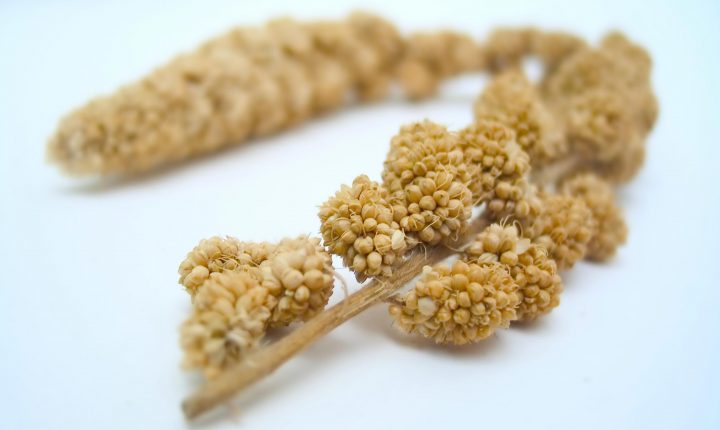
Millet is for the birds… and your pillow!
Millet hull pillows are a lesser-known alternative to buckwheat pillows like our own Hullo.
Many are immediately familiar with millet due to its unique smell. It is the primary component of most bird seed. Both millet and buckwheat are grown primarily for the nutritious grains they produce. Hulls are the byproduct of the milling process; they are left behind when the edible nutritious part of the plant (groat) is extracted. The hulls, in both cases, happen to work very well as pillow fill.
I’m a big fan of buckwheat hull pillows, but I do have a millet hull pillow at home that I enjoy. Like my first buckwheat pillow, it took me awhile to get used to it.

Sustainable Practices in Millet Farming
First let’s acknowledge one of the best things about millet hull pillows: they’re undeniably eco-friendly. Like buckwheat, millet’s cultivation stands out for its low environmental impact—it grows with minimal water, thrives in poor soil, and doesn’t depend heavily on chemicals. While we don’t offer millet hull pillows ourselves, we think highlighting such practices encourages a more sustainable industry overall.
Millet Hulls: Sleep heavy… or light?
I bought some millet hulls online and carefully filled a 20×26″ case. When it appeared full, I was surprised by how much lighter it seemed than my buckwheat pillow. I tested my new pillow and found that when pressure was applied, the millet hulls slid away from the pressure point causing the pillow to “bottom out,” offering little support for my head and neck. I added more hulls to compensate. It took about 7 pounds to fill my standard-sized case to a desired thickness. For comparison, my buckwheat hull pillow has 8 pounds of fill. The additional volume required to sustain proper support for my head and neck negated my initial impression of the millet being substantially lighter.
Soft and Silky: How can that be a bad thing?
Being that I’m accustomed to sleeping on a buckwheat pillow it was a little strange at first. Millet hulls feel totally different. The most obvious difference is that the millet hulls really give, or collapse, when you put pressure on them. Your head will sink deep into the pillow. It feels soft compared to other similar pillows filled with microbeads or buckwheat hulls. The fill smoothly moves against itself adapting to any applied pressure. Thus, those resistant to the idea of a very firm pillow might adapt to a millet hull pillow more quickly than a buckwheat hull pillow.
Quiet! I’m sleeping on this pillow!
Millet hulls not only feel different than buckwheat they also sound different. Buckwheat hulls make a rustling sound when moved, but the millet hulls were nearly silent as they shifted around inside my pillow case. I’ve never been bothered by the sound of buckwheat hulls, but I have heard that complaint from a few buckwheat pillow users. Chalk silence up as a benefit of millet hulls.
Initially I was pretty excited that I’d found something superior to my buckwheat pillow. It seemed very promising. I spent a few weeks sleeping on it.
My millet hull pillow was lacking in a few ways.
Millet hulls can have a very strong odor.
I didn’t mind it too much, but my wife was really bothered by it. It reminded her of birds and well, bird shit (years ago we had a smelly pet parrot). For the benefit of sleep science, my wife persevered and allowed the experiment to continue. Fortunately after a couple weeks the millet smell faded almost completely.
To maintain proper support (my head kept sinking to the mattress), I had to keep readjusting or fluffing it up.
Unfortunately the millet hulls don’t grip together like buckwheat hulls do and thus the pillow doesn’t keep its shape very well. The divot containing my head slowly sunk to the mattress, causing my neck to bend downward at an unnatural angle.
I added more millet, thinking it’d offer better support. Although the loft (height) was now correct, it wasn’t as comfortable. Being so full, it no longer conformed to the shape of my head. The hulls would move away only so far as the fabric case would allow. The pillow became so firm that it felt like a bag of sand.

A breathable pillow will help you stay cool all night.
Millet hulls don’t allow air to circulate like a buckwheat pillow and thus, the millet is noticeably warmer.
A breathable pillow is a cool pillow. Unfortunately millet hulls are much smaller than buckwheat and thus don’t offer the same breathability. There’s much more space between the buckwheat hulls for air to circulate, which helps to keep it cool all night.
After a few weeks, I ended up going back to my trusty buckwheat pillow, but I didn’t abandon my millet hull pillow. It’s still in my bed. It’s great for reading-I put it on top of my buckwheat pillow for a soft squishy boost to my favorite sleeping pillow. I have always liked sleeping with a second pillow under my arm so my millet hull pillow has replaced a tired old down filled one by my side.
Millet Hull Pillow Advantages:
- Millet is lighter weight than buckwheat (although not by much).
- They feel soft and “smooth.”
- It’s quiet-the millet hulls don’t rustle when moved.
Millet Hull Pillow Disadvantages:
- The tiny millet hulls restrict airflow which makes it less effective than a buckwheat pillow at keeping your head and neck cool (Note that it’s still considerably more breathable than a down or polyester pillow).
- The strong smell of bird seed can turn some people off. The smell fades over time, but it can be quite strong when freshly harvested.
- Millet hulls offer little support for your head and neck. It “bottoms-out” easily if the enclosing case isn’t filled close to capacity.
A millet pillow’s lack of support is a deal-breaker for me; I can’t use it under my head for sleeping. Don’t get me wrong, it’s still a decent pillow. I’d definitely prefer it to a down or polyester filled pillow any day. The soft, silky feel really is appealing and I’m sure it would work well as a bed pillow for a lot of people.
Millet Hull Pillow vs. Buckwheat Pillow
For most people, I think that a buckwheat pillow is preferable. Give one a try and I think you’ll agree that it’s superior to other pillow types. Don’t take my word for it — check out these customer reviews.

Insomnia can make it hard to focus.
The Symptoms of Insomnia Are Brutal
Insomnia is the inability to sleep sufficiently, despite the opportunity to do so. Those suffering from insomnia are unable to fall asleep and/or remain asleep. When a sleepless night turns into weeks and months, it can become crippling to one’s quality of life. Unfortunately, it is our most common sleep problem: forty-eight percent of Americans suffer from insomnia periodically.
The Symptoms of Insomnia Include:
- an inability to fall asleep.
- a difficulty returning to sleep.
- consistent trouble with exhaustion during the daytime.
- problems with concentration.
- anger issues, an inability to civilly interact with others.
Sleep is mandatory to safeguarding your physical and mental fitness. There’s no shortcuts-you have to sleep. Before you diagnose yourself an incurable insomniac, you should know the difference between the two main types of insomnia: primary and secondary.
What Are Primary and Secondary Insomnia?
Those suffering from primary insomnia have sleep problems that are not related to any other health issues. It is not attributable to a medical, psychiatric, or environmental cause. The roots of primary insomnias are sometimes hard to uncover and treat.
Secondary insomnia is when sleep problems are the result of something like pain, medication, a health condition or substance abuse. More specifically, secondary insomnia is insufficient sleep due to an externally imposed restriction of some sort. If you’re working too late or snorting lines of coke all day and then can’t get the sleep you need, you’re suffering from secondary insomnia.
Primary Insomnia Treatment: Stimulus Control
The accepted treatment for primary insomnia is stimulus control. It can also be effective for treating those suffering from secondary insomnia as well. The intent of stimulus control is to teach yourself that your bed is for sleeping only.
Stimulus Control? Here’s How It Works:
- Go to bed only when you’re ready for sleep or (if you’re lucky) sex.
- If you’re unable to sleep within 15 – 20 minutes, get out of bed and do something to occupy your mind.
- Maintain a consistent sleep schedule no matter how much you actually sleep.
- Avoid napping.
Secondary Insomnia Treatment: Find the Source
Consider the possible controllable external sources for your insomnia. Find the cause and then an appropriate remedy. The most common cause is strangely easy to ignore: you’re simply not allowing yourself enough time to rest. People are quite good at writing off the need for adequate sleep. It’s easy to cite the general responsibilities of life as necessary time sponges that can’t be avoided.
Think about your day. What different tasks and rituals do you perform? Perhaps you can be more efficient with these or even eliminate one or more. Find time for rest!
Insomnia: A Series of Rough Nights Can Turn Into a Problem
Insomnia always starts somewhere, but there’s no line in the sand. Generally it’s a gradual progression of worsening symptoms. If you’re having trouble getting through the day due to exhaustion you’ve got a problem on your hands. We are meant to wake up refreshed and feeling well-rested. Don’t kid yourself into believing that being tired is just “how it is.” Take control of your sleep and live a fuller life!

“I slept wrong and my neck is killing me!” Jill fell for the BOGO offer from that MyPillow guy and boy does she regret it.
Have you woken with neck pain from sleeping in an awkward position? Often this ache is nothing more than an annoyance, but it can sometimes be extremely painful, preventing you from turning your head.
Mornings used to consistently greet me with neck pain. In my search for relief, I stumbled upon several remedies—quick fixes to ease the discomfort and finally a lasting solution that finally turned my mornings around.
Occasional neck pain from sleeping incorrectly is a common issue.
Deep in sleep, your head can fall into a position that puts unnecessary stress upon your neck muscles. After a bit, your neck may get agitated. Your sleeping brain might do you a solid and command your body to reposition itself so that your neck gets a little relief. Alternatively, you ignore the agitation, exacerbating the strain. As a result, you’ve got a pain in the neck the next morning. Damn you, sleeping brain!
There’s a lot of different things you can do to avoid this sort of neck pain after sleep in the future: change your sleeping position, try a new pillow or even, god-forbid… exercise!
But what can be done about the neck pain I’m feeling right now?
I’ll bet you’re not very interested in exercise at the moment. You need quick relief! Here’s how to get rid of neck pain from sleeping wrong right now.
1. Give your neck a rest.
Your giant head weighs around 11 lb. That’s a lot of weight that your neck needs to support. Give your muscles a break. If you’ve got some time to spare, lie down. Make sure your head is supported in a neutral position and that you’ve got a comfortable pillow. More rest is often the best remedy even if you just rolled out of bed.
2. Do your best to avoid stress.
Are you worried that the boss will find out you’ve been stealing from the business for years? Worried of an early death? Forget your problems and watch a movie or read a book! I recommend Ozark on Netflix.
3. Ice in short increments.
It can work well for some, but cooling can aggravate more serious issues, so If the pain worsens, remove the ice immediately.
4. Have a partner massage the affected area.
Who doesn’t appreciate a good massage? Neck pain or not, it generally makes life in the moment a little better.
5. Use a warm compress.
A warm damp towel (use a microwave to heat it) can help to increases circulation and is often effective in providing relief to stiff muscles. Beware, heat can make inflammation worse, so if your symptoms deteriorate, remove that heat immediately!
6. Pop a few of what modern medication has to offer.
Aspirin, acetaminophen, or ibuprofen can help a lot if the pain isn’t too ridiculous. It should go without saying, but please follow the directions on the packaging.
7. Stretch the muscles in your neck.
It’s always best to warm up muscles before stretching, so it’s advisable to take a hot shower or use a hot compress first. The key with stretching is to not overdo it! Here’s 4 of the simpler stretches recommended by WebMD:
- Slowly turn your head to the left. With your left hand, apply very light tension on your chin so that your head turns slightly more. Hold for 20 seconds and return your head slowly to center. Repeat on the right side.
- Tilt your head to the left and try to touch your left ear to your shoulder. With your left hand, apply light pressure on your temple. Hold for 20 seconds and repeat on the right side.
- Bend your head forward and try to touch your chin to your chest. Relax the shoulders as you do this. Hold for 20 seconds and repeat.
- Lie on your back with your knees bent and a pillow under your head and neck for support. Nod your head forward gently, as though you were saying “yes.” Hold the position for 10 seconds and then relax. Repeat 10 times.
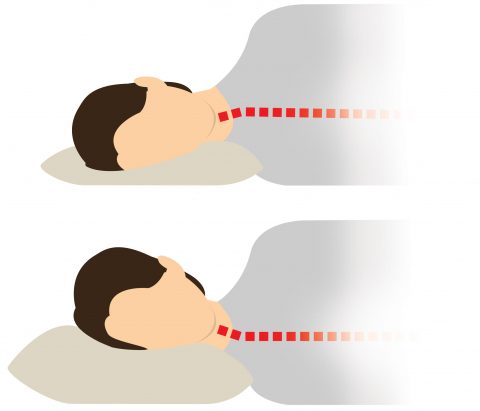
If your pillow doesn’t keep your head at the correct level, it is likely you will experience back and neck pain.
Consistent pain in the neck? Let’s dive a bit deeper and look at some long-term solutions…
Remember, these are just temporary fixes! If you had a bad night, try all of the above and hopefully you’ll get some relief.
However, if you’re experiencing neck pain from sleeping on a consistent basis, do something that addresses the root of the issue(s) rather than just treating the symptoms.
Experts suggest modifying your sleep environment.
It’s not just about having a bed that feels like a cloud. Your mattress should have your back (literally), supporting you just right so your spine stays straight and happy all night long. And your pillow? That’s your neck’s best buddy. You want something that keeps your neck in line, like it’s doing a perfect yoga pose while you snooze. There’s a world of pillows and mattresses out there – and no single type is right for everyone. Make sure you try several until you find one that works. Many companies (ours included) have generous return policies that allow you to test drive them in your own home.
Try a new pillow first.
The wrong pillow can exacerbate or even be the cause of your neck pain. Often the solution is simple: replace your pillow with a more suitable one. A good pillow will keep your spine from bending unnaturally upwards or downwards and provide comfortable, even support for your entire head and neck. An ill-suited mattress can also cause neck pain, although that is less commonly the culprit. A new mattress is also an expensive solution, so try some different pillow options first!

Beautiful buckwheat hulls: Hullo Pillow’s contents are revealed.
Have you ever tried a buckwheat pillow?
Before I discovered buckwheat pillows, my mornings were a literal pain in the neck. I tried everything—memory foam, down, synthetic—you name it, all to no avail. Then, a friend mentioned he’d switched to a buckwheat pillow and was sleeping like a baby, neck pain-free. Skeptical but desperate, I decided to give it a shot.
The first night was a bit of an adjustment; the rustling sound of buckwheat hulls and the firmness were new to me. However, I woke up the next morning without the usual stiffness in my neck. It felt like a small miracle. Days turned into weeks, and my neck pain, a faithful companion for so long, simply vanished.
The more I used it, the more I loved it. Not only did it alleviate my neck pain, but it also stayed cool throughout the night and easily adapted to my preferred sleeping position. It’s been a game-changer for my sleep quality and my life. I’ve never looked back since that switch.
In fact, I like these unique pillows so much that I decided to manufacture and sell them. Don’t take my word for it! Our customer’s reviews speak for themselves.
“For a few years, I have been searching for a pillow that allows me to wake up without neck pain. I have literally spent nearly $1,000 on pillows. Soft, firm, memory foam, contour, gel, designed by sleep specialists, etc… I have tried them all with no relief. I got my Hullo pillow yesterday and this morning is the first morning in years I have awoken with no neck pain. Love my Hullo!” -Valerie, verified Hullo customer
Sleep on Hullo buckwheat pillow for 60 nights. If it doesn’t work for you, just ship it back to us and we’ll refund the purchase price.
Additional Sources: Effects of Acute and Chronic Stretching on Pain Control
 First, Some Good News for Back Sleepers
First, Some Good News for Back Sleepers
Sleeping on your back is considered the best way to sleep by doctors and sleep experts. When on your back, your head and neck are both in a near ideal neutral sleeping position. A neutral sleeping position keeps all the bits and pieces in your back in in their ideal positions, preventing unnecessary pressure on your discs, muscles and nerves. Keep your spine neutrally aligned and you’ll avoid discomfort (and worse).
If you’re able to sleep on your back, you’re in the minority. Apparently only 14% of us are back sleepers.
OK lucky back-sleeper, are you looking to improve your rest with a new pillow? The best pillow for back sleepers:
- has adjustable loft so that you can fine-tune the thickness, keeping your head and neck properly elevated off your mattress.
- is firm and malleable, providing even and consistent support without pressure points.
The thickness of your pillow matters, particularly for back sleepers!
Most people are side sleepers and require a thicker pillow to keep the head and neck aligned properly. Thus, many pillow manufacturers design their products to efficiently accommodate this majority. Most of these generic pillows are non-adjustable, leaving back sleepers with pillows that are simply too thick.
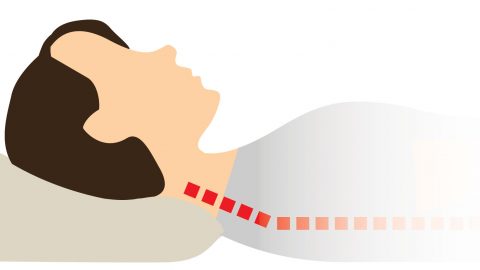
Back sleepers may be familiar with the discomfort associated with a pillow that is not the correct thickness.
The best pillow for back sleepers will adequately fill the space between yourself and the mattress, elevating your head only as high as is needed to achieve a neutral position. A pillow that’s too thick will cause your head to be elevated too high. As a result, your neck is bent upwards, potentially straining muscles, nerves and discs. Conversely a pillow that’s too thin will result in an uncomfortable downward bend in your neck.
If you opt to buy a non-adjustable pillow type, shop carefully!
It’s very easy to end up with a pillow that’s either too thick or too thin. There really is no substitute for literally “sleeping on it.” Squeezing a pillow inside plastic packaging at the store isn’t the way to find your ideal pillow. You really need to test drive them in your own bed if possible. Check the manufacturer’s return policy and make sure that you’re able to try it for at least a week. If it’s not right for you, toss it back in the box and return it. You spend a third of your life with your head resting on a pillow, so a little shopping and experimentation is absolutely worth it.
A supportive, malleable pillow will prevent lateral neck twists and strains.
When on your back, gravity will pull your head to your left or right shoulder as you sleep. The ideal back sleeper pillow keeps your head positioned relatively straight, or upright. This reduces the lateral twist in your neck that will cause unnecessary stress.
Unfortunately many of the most popular pillow types aren’t capable of providing the support back sleepers require. They collapse under the weight of your head (foam), or simply aren’t malleable (memory foam).
The Best Pillow for Back Sleepers? We Recommend Buckwheat Pillows
Most well-made buckwheat pillows are adjustable. They will include a zipper on the side, allowing you to add or remove fill so that its loft is just right for you. In most circumstances, you’ll want to remove some of the buckwheat hulls from a newly purchased buckwheat pillow to make it appropriate for a back sleeper.
Buckwheat pillows are well-known for their malleability. They will conform perfectly to the contours of your head and neck providing even and consistent support all night long. It will hold its shape, and prevent your head from slumping from one side or the other.
Buckwheat pillows will stay cool all night long thanks to the breathable nature of their filling. Warm moist air quickly circulates through the buckwheat hull fill and is continually replaced with cool fresh air while you sleep.
Finally, buckwheat pillows are made from all natural materials that are safe for you and the environment.
Please consider our product, Hullo™. We think it’s the best buckwheat pillow available, but don’t take my word for it, check out these customer reviews.
Read more:
Instead of ties, tools, golf clubs or gadgets, give the gift of great sleep. Read below to learn how our simple natural pillow is a great gift for men.
Top 10 Reasons Hullo Makes a Great Gift for Men:
-
Men Love to Sleep
Let’s face it, sleep is one thing most men can’t get enough of. Anything that can help them fall asleep faster and stay asleep longer is a gift they will remember for years to come.
-
Hullo Is Tough & Rugged
Hullo is built to last. Our durable cotton twill cover, reinforced seams and heavyweight hidden zipper mean that with proper care, Hullo will last many years with proper care.
-
Hullo Is Simple
Just like the man in your life, Hullo is simple; Unbleached cotton twill cover, durable zipper, and the finest buckwheat hulls we could find. Like fine wine and cheese, some of the best things in life use only a few basic ingredients.
-
Hullo Is Adjustable
Most men like to tinker with things to get them just right. Hullo’s hidden zipper allows them the ability to add or remove hulls and adjust the pillow to their desired thickness.
-
Hullo Stays Cool
There’s nothing worse than having to flip your pillow over and over throughout the night to keep your head cool. Hullo’s all natural filling allows air to circulate through the pillow keeping it cool all night long.
-
Hullo Has a Sensitive Side
While being a tough and durable product, Hullo is also sensitive to touch and conforms perfectly to your head and neck. As you move throughout the night the pillow adjusts to your every move.
-
Hullo Can Relieve Neck and Back Pain
Whether he works in construction or sits behind a computer all day, neck and back pain can make it difficult to fall and stay asleep at night. Hullo’s buckwheat hull fill conforms to the shape of your head and neck and allows for proper alignment of the spine which can reduce neck and back pain.
-
Hullo Works Great as a Wedge
If he reads or watches TV in bed, Hullo makes a great wedge with firm support.
-
Hullo Is All Natural
Unlike most pillows, From the 100% organic cotton twill case, to the carefully sourced buckwheat hulls, Hullo contains no chemicals or animal products.
-
Hullo is Made in U.S.A
We support American farmers and manufacturers. Our buckwheat pillows are Made in the U.S.A. with the finest materials available.
Looking for a different sleep gift? We’ve compiled another list of 5 great sleep gifts here.
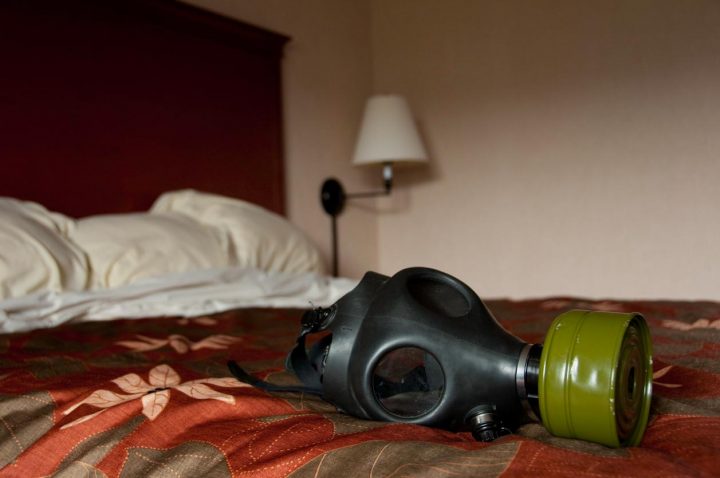
Some of the chemicals used in memory foam aren’t entirely benign.
Does Your Memory Foam Pillow or Mattress Have an Unpleasant Chemical Smell?
One of the biggest complaints by owners of memory foam pillows and mattresses is the unpleasant, and potentially unhealthy chemical smell. Memory foam is manufactured using polyurethane and several other chemicals, so it isn’t surprising that it emits a chemical odor. This “off gassing” of volatile organic compounds is a common and well-documented property of memory foam pillows and mattresses. The fumes are often compared to those experienced in a freshly painted room. If you are experiencing this odor, the good news is you may not have to endure the smell for long. The bad news is that some of the chemicals used in memory foam aren’t entirely benign.
Will the Odor Go Away?
Many memory foam mattress owners report that the off gassing period ends after a number of days. Of course there are many factors which influence this including the product, the type of foam, the sensitivity of the person, the room ventilation and more. Even if the initial odor goes away, it is natural to wonder if there are health issues related to off gassing.
Health Issues Related to Memory Foam Smell
Most people do not report any health issues resulting from their memory foam pillow or mattress. However, there are various reports of headaches, nausea, and allergic reactions resulting from the odor produced by memory foam. If you are experiencing any of these symptoms, you’ll want to avoid sleeping on the foam during the initial off gassing period. You can leave the pillow or mattress in a well-ventilated area for a week or two and see if that helps eliminate or reduce the odor and symptoms. If after several weeks, the issue persists, it is probably time to consider an alternative to memory foam.
Is Long-term Use of Memory Foam Healthy?
 Many many people use memory foam products without reporting any side effects or related health issues. That said, there are various reports and studies which indicate that memory foam may be somewhat toxic. Reports include carcinogenic chemicals and formaldehyde gas. To manufacture memory foam, chemicals are added to polyurethane to make it more dense and viscous at the same time. Additional chemicals are required to make the polyurethane flame retardant. One of these, Pentabde (of the polybrominated diphenyl ether (PBDE) family), was used until 2004. Pentabde is now known to be toxic to the liver, thyroid, and nervous system.(1) A study in 2000 specifically found mattress emissions to be toxic to the lungs of labratory mice.(2)
Many many people use memory foam products without reporting any side effects or related health issues. That said, there are various reports and studies which indicate that memory foam may be somewhat toxic. Reports include carcinogenic chemicals and formaldehyde gas. To manufacture memory foam, chemicals are added to polyurethane to make it more dense and viscous at the same time. Additional chemicals are required to make the polyurethane flame retardant. One of these, Pentabde (of the polybrominated diphenyl ether (PBDE) family), was used until 2004. Pentabde is now known to be toxic to the liver, thyroid, and nervous system.(1) A study in 2000 specifically found mattress emissions to be toxic to the lungs of labratory mice.(2)
The long-term effects of memory foam and its toxicity are not fully understood, but there clearly is some reason for concern. Aproximately one-third of your life is spent in close contact to your sleeping surface, so it is important to consider you and your family’s health when selecting a pillow or mattress.
Natural Alternatives to Memory Foam Pillows
Are you interested in the support and comfort provided by memory foam, but want to avoid that chemical smell? There are several natural pillow options for those looking for a new pillow. Of course, our favorite is our buckwheat hull pillow. Besides being natural and chemical-free, buckwheat pillows are a great alternative to memory foam for a couple of other reasons.
Memory foam is not breathable and this can result in a hot and sweaty pillow. The shape and particulate nature of buckwhat hulls leaves a lot of air space in your pillow between all of the hulls. This airspace allows warm moist air to escape, leaving your pillow cool and dry.
While a memory foam pillow conforms to the shape of your head, the overall shape and thickness of the pillow is fixed, making the pillow less adaptable to your sleeping position. The fill in a stuffed pillow can be shifted and adjusted for a wider variety of shapes and sizes.
If you’ve decided against a memory foam pillow and a buckwheat pillow isn’t right for you, other natural alternatives to memory foam include pillows filled with down, cotton, wool, latex, kapok or millet hulls.
- http://www.enn.com/pollution/article/33754
- http://www.ncbi.nlm.nih.gov/pubmed/10735518
“Sorrow can be alleviated by good sleep, a bath and a glass of wine.” –Saint Thomas Aquinas

Sleeping with your arm under your head or body can result in numbness and tingling.
It’s common for people to wake up with numbness and tingling in their arm or hands. This is often due to sleeping with an arm beneath your body or head. When there is enough weight on your arm, it can compress nerves which results in numbness or tingling. This is often referred to as having one’s arm “fall asleep”.
Arm numbness is most common in side sleepers, as this position results in you lying on one arm. The median nerve, which runs the length of your arm, is compressed. Excessive compression can result in numbness.
If you’re sleeping on your side, and waking up with a numb arm, there are things you can do to help avoid the problem.
How can I avoid waking up with my arm numb?
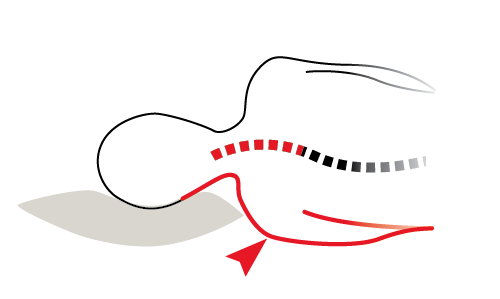
The wrong pillow can exacerbate nerve problems in your arm.
Be aware of your sleeping position. Are your head and neck being supported properly? Many people do not know that their pillow can have a significant impact on nerve compression in your arms. If your pillow is not supporting your head properly, nerve compression problems can become worse. Try using a pillow that is firm and thick enough to support your head and neck.
The firmness of your mattress also is a factor in your sleeping position and comfort. Since your body does not sink far into a firm mattress, your head is naturally higher off the surface of the bed, usually necessitating a firmer, thicker pillow.
Eliminating your arm numbness and tingling might be as simple as changing to a different pillow type, like a buckwheat pillow.
If a new pillow doesn’t resolve the issue you can try sleeping on your back. It’s not easy — I’ve tried it myself!
What should I do when I wake up with my arm numb?
Generally if you roll over to relieve the pressure, the numbness and tingling will quickly subside. Moving your hands and arm can help restore feeling in your arm after waking up. Experimenting with different pillows, mattresses and different sleeping positions can help you find relief. If you experience extreme numbness or pain, or numbness not related to sleeping on your arm, you should speak with your doctor to make sure it is not something more serious.
